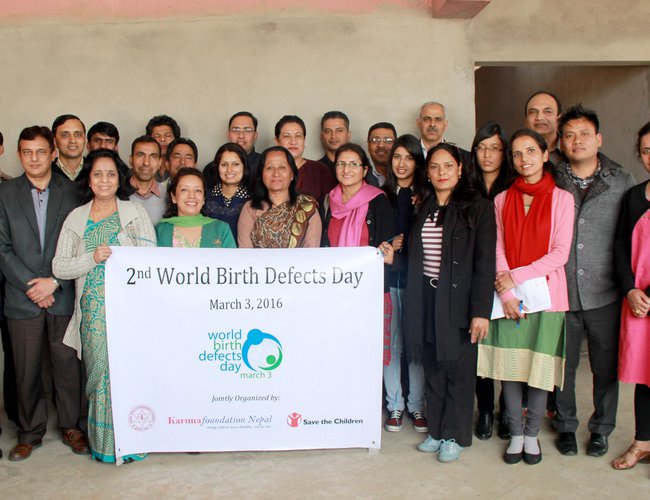
Karuna Foundation Nepal (KFN), Nepal Health Research Council (NHRC) and Save the Children organized celebrated a second World Birth Defects Day WBDD organizing half day program on 3rd March at NHRC Training Hall. on the Second WBDD as a way to talk about the different types of birth defects, its causes and prevention.
The 3rd of March is known as World Birth Defect Day (WBDD). This day is a way to create awareness about how various events during pregnancy can cause birth defects. A birth defect is a problem that happens while a baby is developing in the mother's body. Most birth defects happen during the first 3 months of pregnancy.
Moderated by Dr. Archana Amatya, Deepak Raj Sapkota, Executive Director of KFN highlighted the importance of the WBDD in the context of reducing the person with disabilities.
Presenting his paper, Ram Krishna Thapa Karuna Foundation talked about the scenario of birth defects in a national,regional, and global level and the history of birth defects in developing countries and the significance of the WBDD. Sharad Sharma, Demographer, Family Health Division of Department of Health Services, discussed about the overview of the birth defects screening and referral program of the Government of Nepal. “Major national policies and plans have not fully addresses birth defect issues but effort to prevent and manage birth defect has been partially integrated into ongoing RH programs. Birth defect record has been integrated to HMIS but cannot provide its type,” he said.
Dr. Dhanaraj Aryal, chief consultant pediatrician at NBBD network, talked about the findings from ten Birth Defects Networking Hospitals of Nepal. “Government has programs that address various issues but the 14% deaths that are caused by other reasons including Congenital Abnormalities are not yet touched by any programs,” said Dr. Aryal
Tulashi Adhikari from Nursing Institute talked about counseling parents of children with birth defects and talked about how psychological aspect is very necessary as it is seen lacking in the health sector. “Doctors talk how they can prevent or help the child but no one talks to family/parents about how it affects them and what should be done for the child,” said Adhikari.
Deepak Raj Sapkota ended the presentation by talking about the role of KFN inprevention and management of birth defects. Dr. Guna Raj Lohani, Chief of Curative Division, Ministry of Health, said that congenital abnormalities is a genuine issue and that it ‘must’ be addressed.
He stressed the needs to be collaboration between stakeholders and Government to significantly reduce preventable birth defects and reduce related mortality and morbidity in Nepal, which is already in the Government’s plan.
In his closing remarks, Dr. Khem Karki, the Member Secretary of NHRC, said that there are ways to prevent birth defects and how psychological counseling is necessary. He also talked about how we know about almost all the causes of birth defects and we need to talk about his in a more socio-economic way with bio-medical information.
Dr. Archana Amatya held an open discussion about the different ways birth defects can be reduced and how to make people aware about it. “There were also talks about how doctors or hospitals in general might not record newly born babies with birth defects and how some situations of stillbirth might be ignored. Stillbirths are not usually looked into to find the actual cause of the stillbirth but are put under a broad umbrella,” said Dr. Amatya.
Experts also held the view that health workers themselves needed to be made aware about the necessity of filling out the forms properly and how stillbirths must be examined to find out the actual cause of stillbirth. “Questions were raised about the provision of folic acid to women who have pre-planned pregnancy because in a developing country like Nepal, we hardly find situations with pre-planned pregnancy,” Dr. Amatya said.
An hour long discussion mostly revolved about how the audience and the speakers themselves were made aware about the different aspects of birth defects and how pregnant women should be carefully monitored in order to prevent congenital abnormalities. Participants also pointed out how adolescents should be thoroughly informed about sexual reproduction and ways to prevent birth defects. Counseling families and parents of children with birth defects was also stressed as a way to further prevent and create awareness and inclusion for people with birth defects or congenital abnormalities.
The end note of the whole program was to find ways to ensure that the government makes specific plans about birth defects and congenital abnormalities and to provide counseling and to have a better way to find out the number of children born with birth defects. The program also talked about how more awareness programs should be organized so everyone knows about birth defects and how to better prevent it in a holistic way.
- TANAHU HYDROPOWER PROEJCT: A Significant Achievement
- Apr 15, 2024
- AMBASSADOR HANAN GODAR: Sharing Pain With A Nepali Family
- Mar 30, 2024
- VISIT OF KfW AND EIB TO NEPAL : Mission Matters
- Mar 25, 2024
- NEPAL BRITAIN SOCIETY: Pratima Pande's Leadership
- Mar 24, 2024
- NEPAL ARMY DAY: Time To Recall Glory
- Mar 15, 2024
















